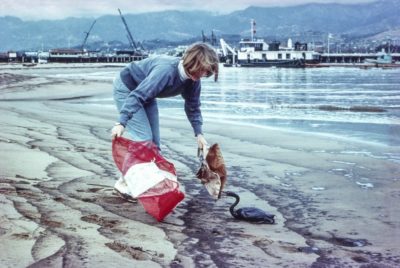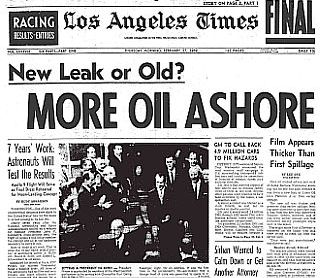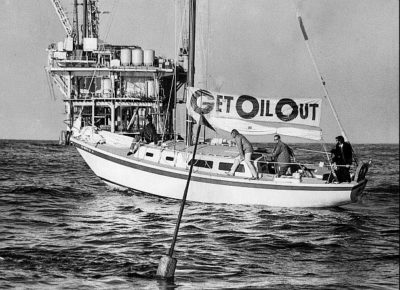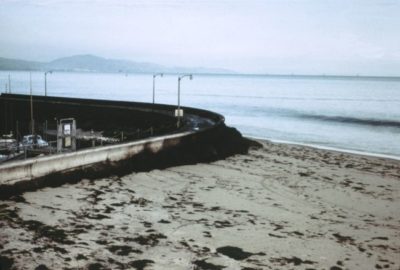Commemorating a Major Environmental Disaster–One With a Transformative Legacy
1969 Santa Barbara Oil Spill Sparked the Beginning of America’s Modern Environmental Era
This week marks the 50th anniversary of one of the most serious and consequential environmental disasters in American history–the Santa Barbara offshore oil spill of 1969. On January 28, 1969, an offshore oil rig (Platform A) owned and operated by the Union Oil Company and operating in federally-controlled waters in the Santa Barbara Channel off the California coast, blew out. Over the next 10 days, between 80,000-100,000 barrels of crude oil spilled into the Channel and onto California beaches stretching from San Luis Obispo County south to San Diego–though the majority of the spill-related damage occurred in Santa Barbara and Ventura Counties. That oil spill killed approximately 3,500 seabirds and an unknown but substantial number of marine mammals including dolphins, elephant seals and sea lions. The spill was not completely capped until early 1970.

A half century later, the Santa Barbara oil spill remains the third largest oil spill in U.S. history, after only the Deepwater Horizon spill in the Gulf of Mexico (2010) and the Exxon Valdez oil spill in the ocean waters of Alaska’s Prince William Sound (1989).
In many ways, however, the January 1969 Santa Barbara spill remains the most consequential and transformative environmental disaster in American history. That’s true for several related reasons. First, it was the inaugural such environmental disaster captured and broadcast into millions of U.S. households on the evening news. For weeks, the major TV networks provided gripping, daily accounts of the biological damage and adverse economic effects produced by the Platform A blowout. And that had a profound effect on the national psyche, with televised footage of dead and dying animals, fouled beaches and oil-saturated ocean waters underscoring in the most stark way the myriad costs associated with oil and gas development in coastal waters.


Second, the Santa Barbara oil spill provoked a strong and immediate response from government leaders. Local officials complained bitterly to the media and public about the lack of adequate environmental controls and oil spill response efforts, noting presciently that the federal government that had issued the oil and gas leases–thereby earning substantial royalties from the oil companies’ offshore development activities–had an inherent conflict of interest when it came to regulatory oversight of those same activities. Federal officials had a more muted reaction to the spill: President Richard Nixon visited the area to view the spill and cleanup efforts on March 21st, telling the assembled crowd, “…the Santa Barbara incident has frankly touched the conscience of the American people.” But on April 1st, a hastily-adopted, temporary federal drilling ban was lifted, and oil and gas development in federal waters resumed off the California coast.

Longer term, however, the Santa Barbara spill would have a direct and positive effect on American environmental policy and law. Later that year, Congress would enact the National Environmental Policy Act (also a half century old this year). And NEPA was but the first in a torrent of environmental legislation passed by Congress over the next decade–including the Clean Air Act, Clean Water Act and Endangered Species Act–that to this day remains the basic framework of federal environmental law.
Environmental activism is another direct outgrowth of the 1969 Santa Barbara oil spill. The next year, U.S. Senator Gaylord Nelson of Wisconsin led efforts to organize the first Earth Day, an annual celebration of the environment and environmental values that continues to this day. Additionally, local, state and national environmental organizations saw their membership ranks swell in the wake of the Santa Barbara oil spill.
The Santa Barbara oil spill also catalyzed a state government response that quickly made California a national and international leader when it comes to environmental policy and law. In the immediate wake of the disaster, the Republican-dominated California Legislature created an interim Committee on Environmental Quality, directing it to develop recommendations for state environmental legislation. The most important outgrowth of that initiative was passage in 1970 of the California Environmental Quality Act; modeled on but significantly stronger than NEPA; CEQA remains California’s most important, cross-cutting environmental law, as well as the most powerful “little NEPA” statute in the nation. And when the California Legislature balked at passing a law specifically designed to prevent ocean and coastal damage exemplified by the Santa Barbara oil spill, state voters responded by enacting an initiative measure in 1972 creating the California Coastal Commission and the most powerful system of coastal regulation and preservation in the nation.
Last but not least, the Santa Barbara spill had a transformative on academia and education. In direct response to an environmental disaster that severely damaged its own coastal campus, the University of California, Santa Barbara immediately created the nation’s first environmental studies program, featuring such luminary professors as human ecologist Garrett Hardin and environmental historian Roderick Nash. Fifty years later, environmental studies programs are an essential part of the curriculum at most of the nation’s colleges and universities. Similarly, environmental law is a key area of specialization at U.S. law schools, and environmental law centers and clinics play a critical role at many of America’s top law schools–including the three University of California law schools that contribute to this blog site.

To be sure, the 1969 Santa Barbara oil spill was a major environmental disaster, one that caused considerable environmental damage to the ocean environment and economic havoc to California’s coastal communities. But the silver lining (if one can call it that) to that disaster from a half century ago is that it–perhaps more than any other single event–brought the need for ecosystem protection and environmental regulation to America’s collective consciousness and ushered in the modern era of environmental law, policy and advocacy.
As we reflect on the 50th anniversary of the Santa Barbara spill, that’s a most welcome legacy of a truly horrific event.

Reader Comments
2 Replies to “Commemorating a Major Environmental Disaster–One With a Transformative Legacy”
Comments are closed.







Rick: Thanks for this great summary of the establishment of NEPA and CEQA. Amazing to think it’s been 50 years. And your approach to showing the positive that came out of such a tragedy was a good one. Amy Skewes-Cox
Thanks, Amy.